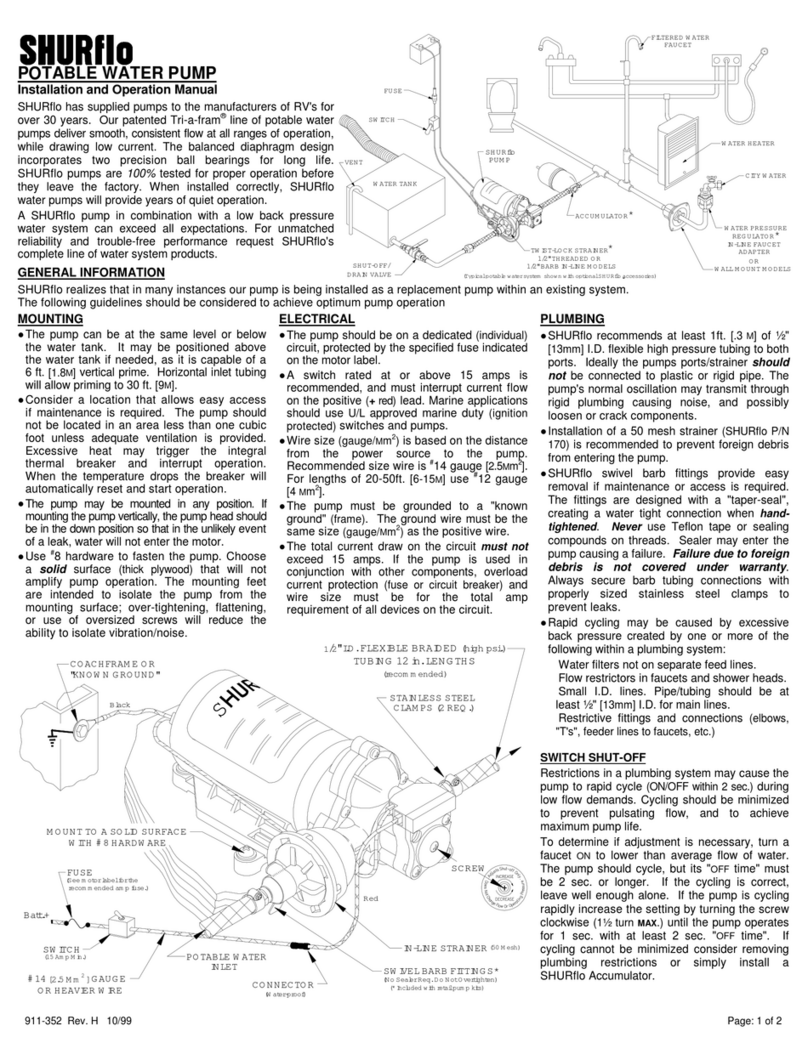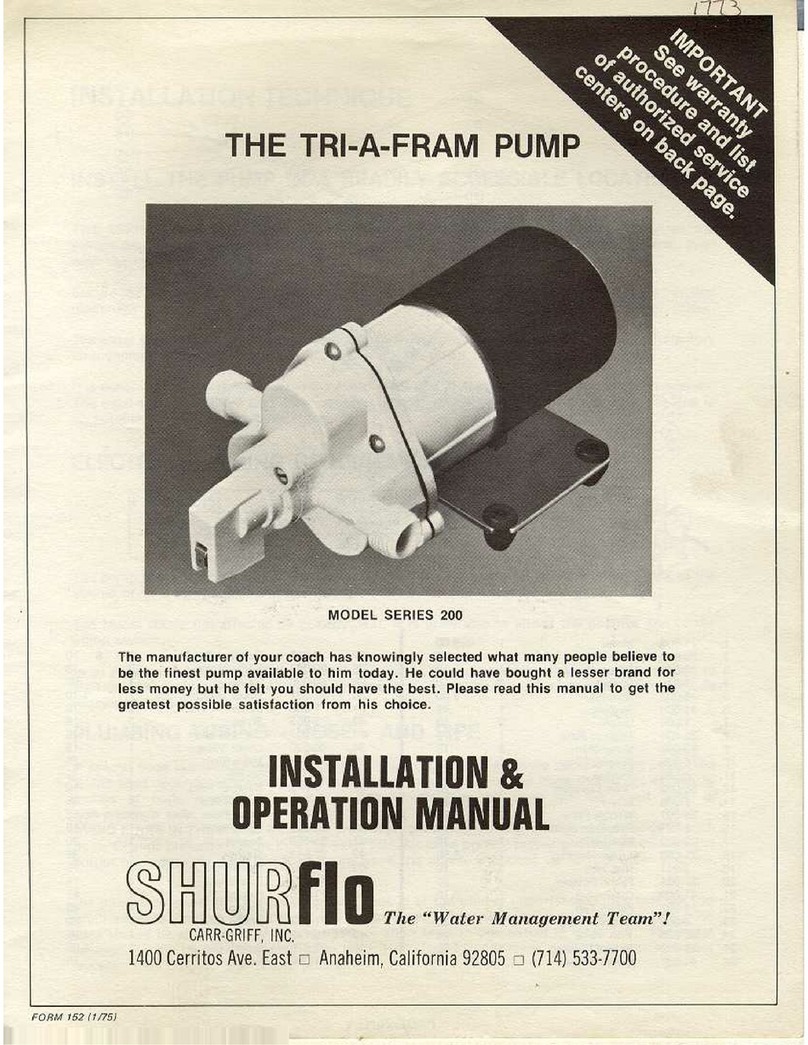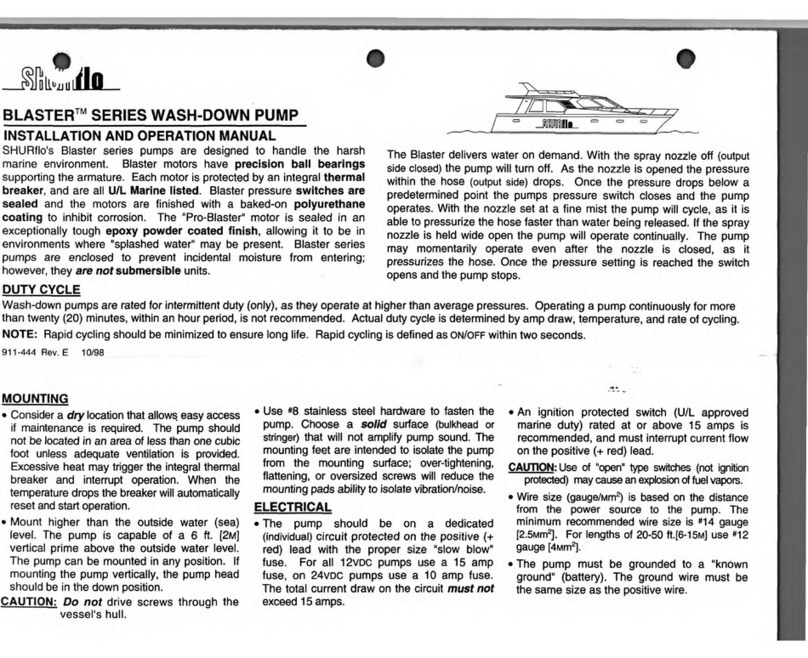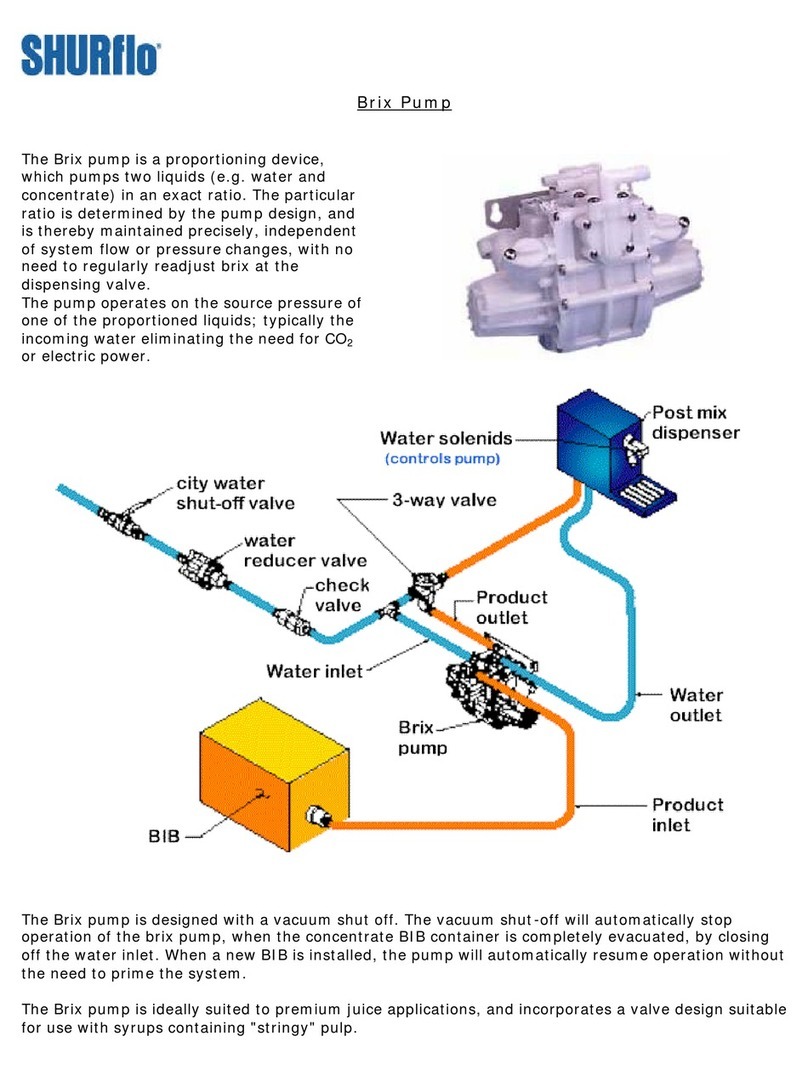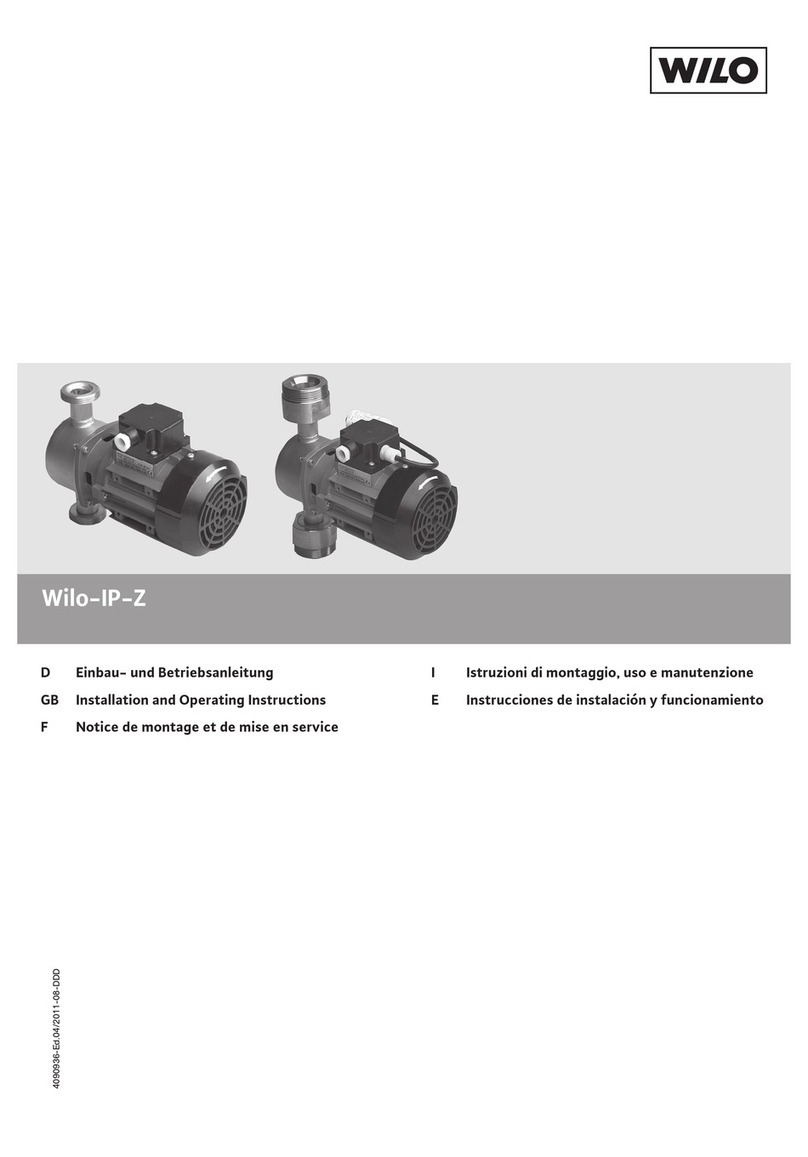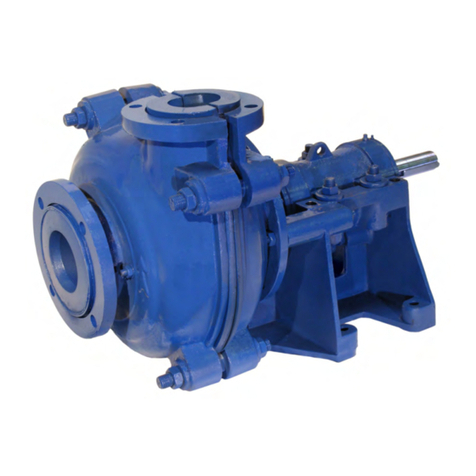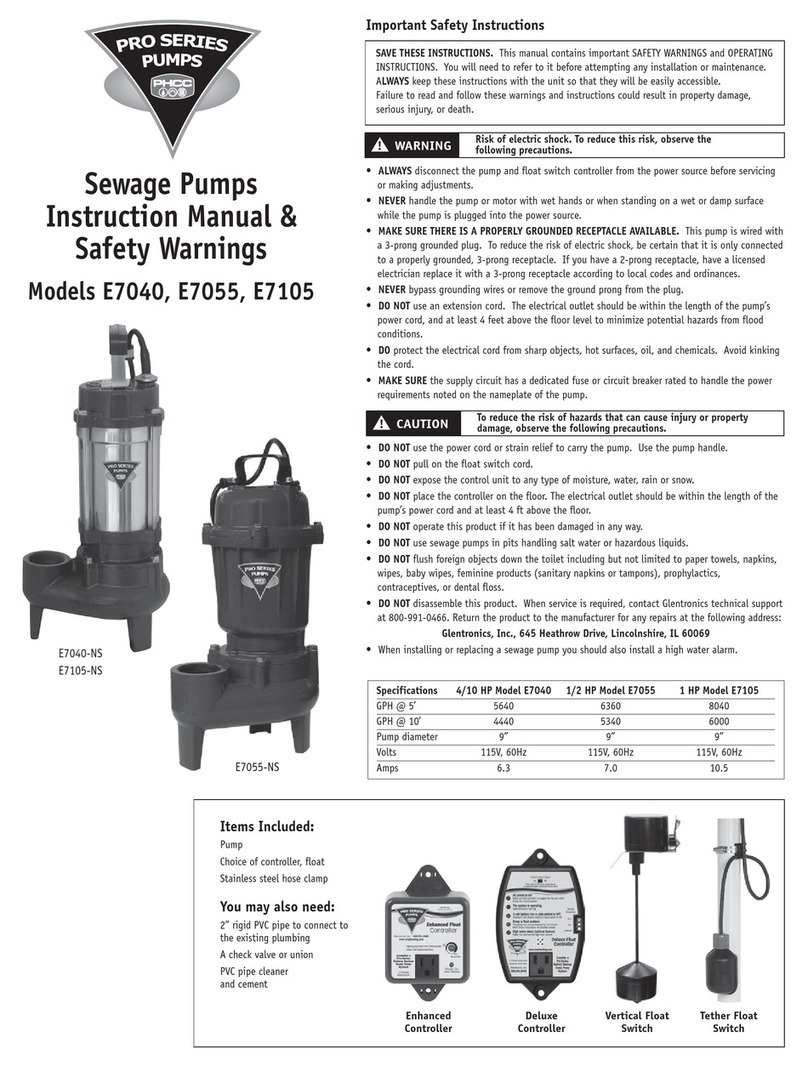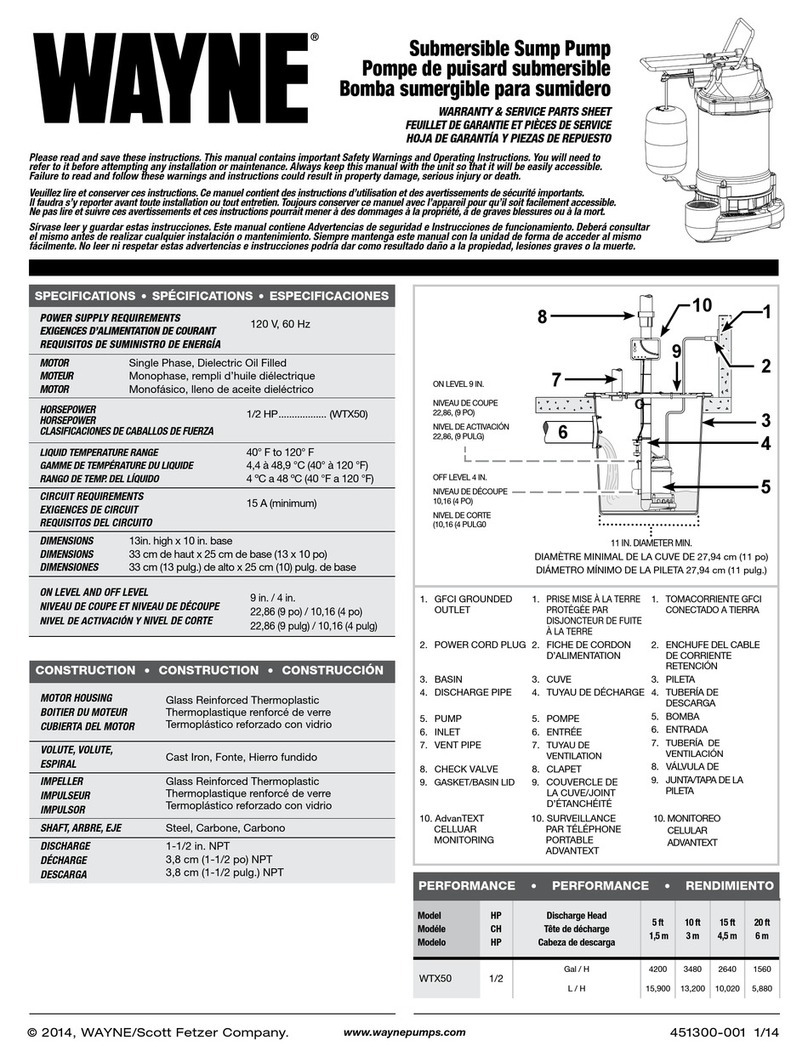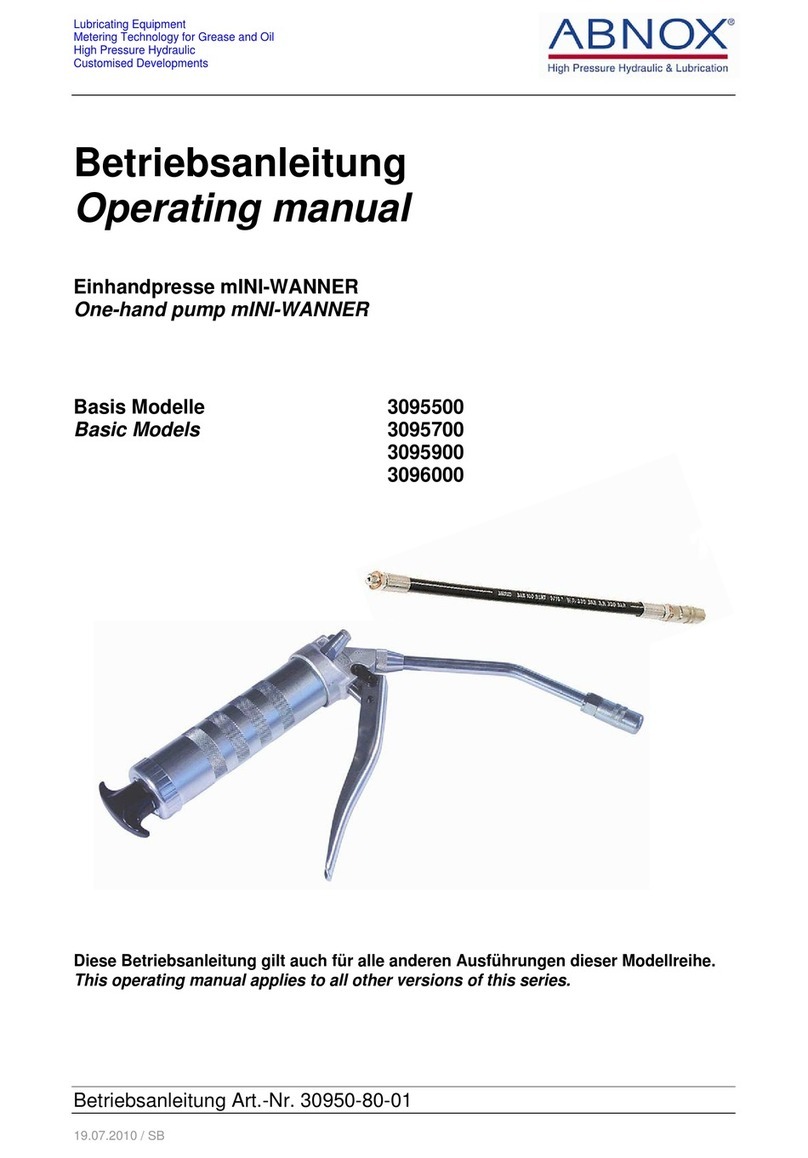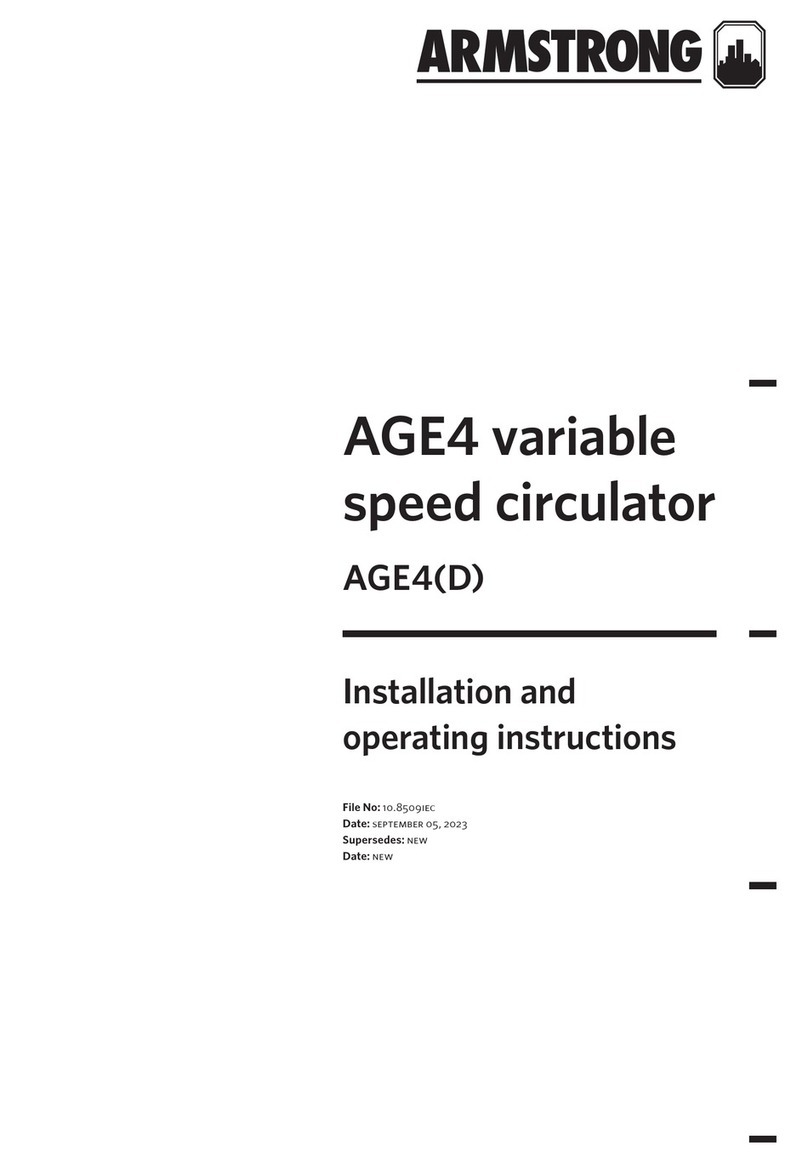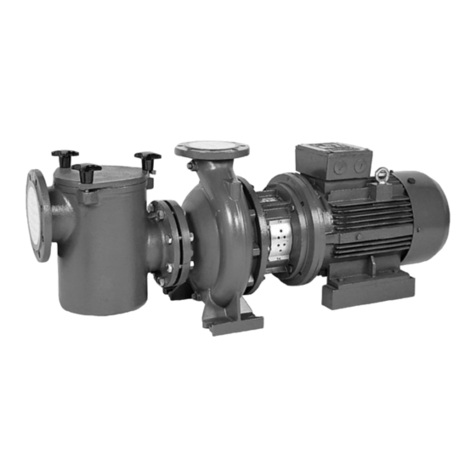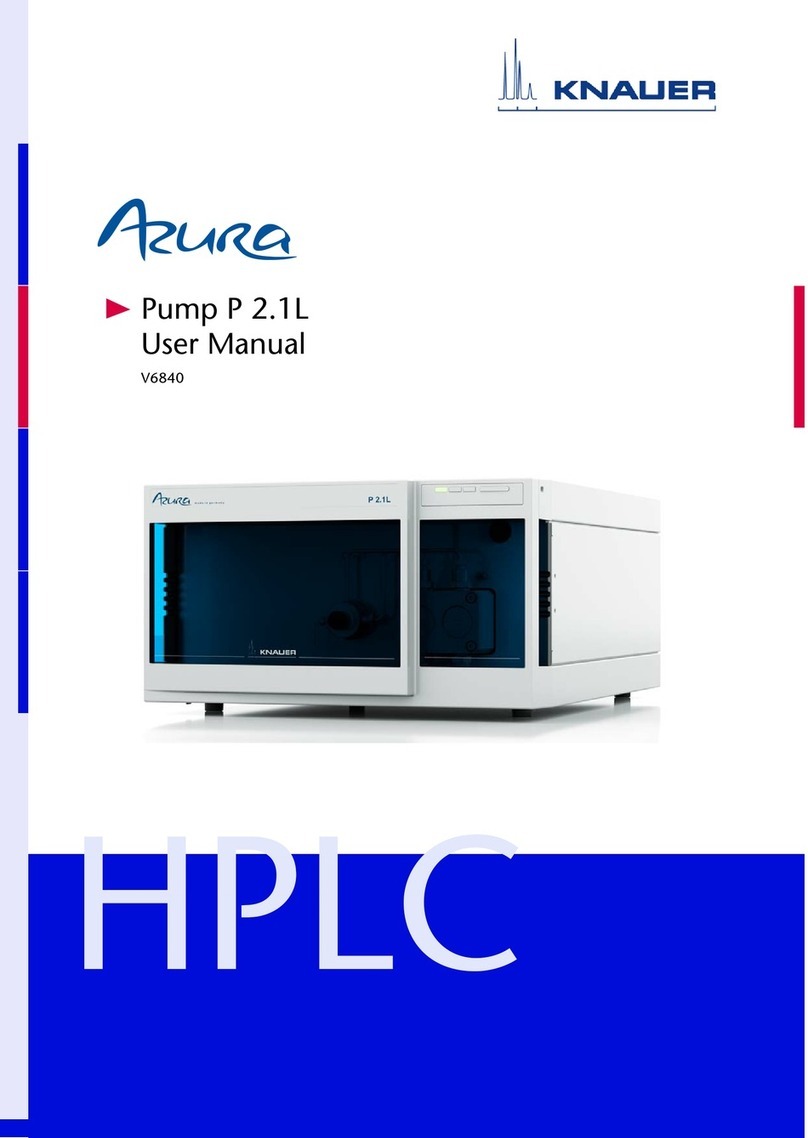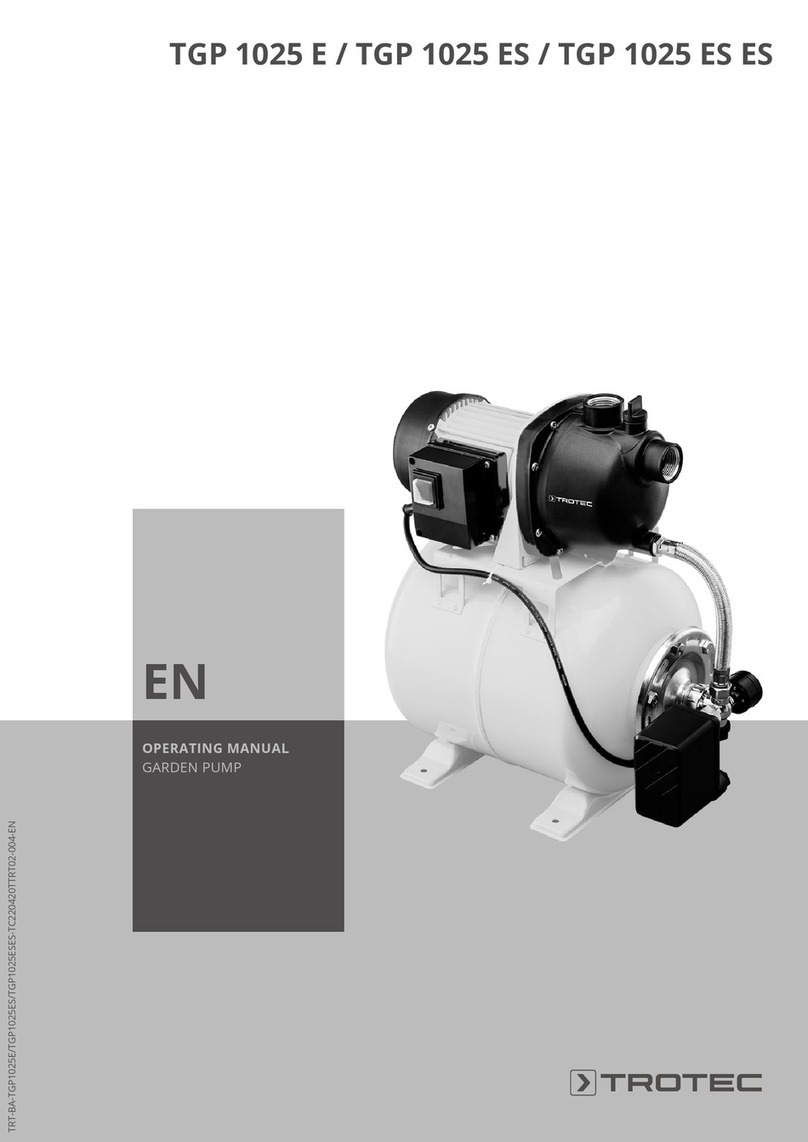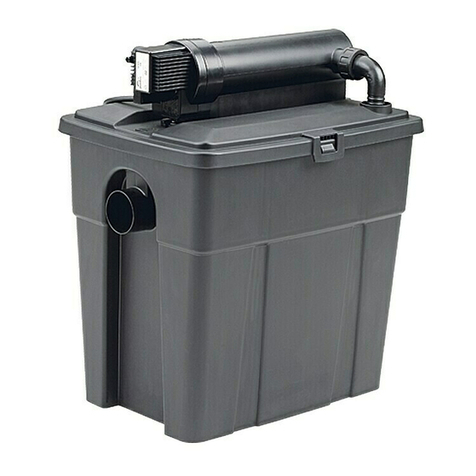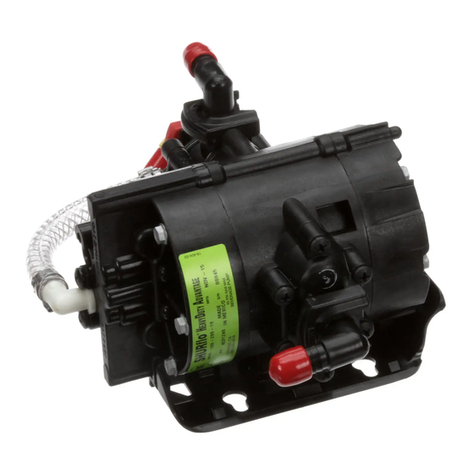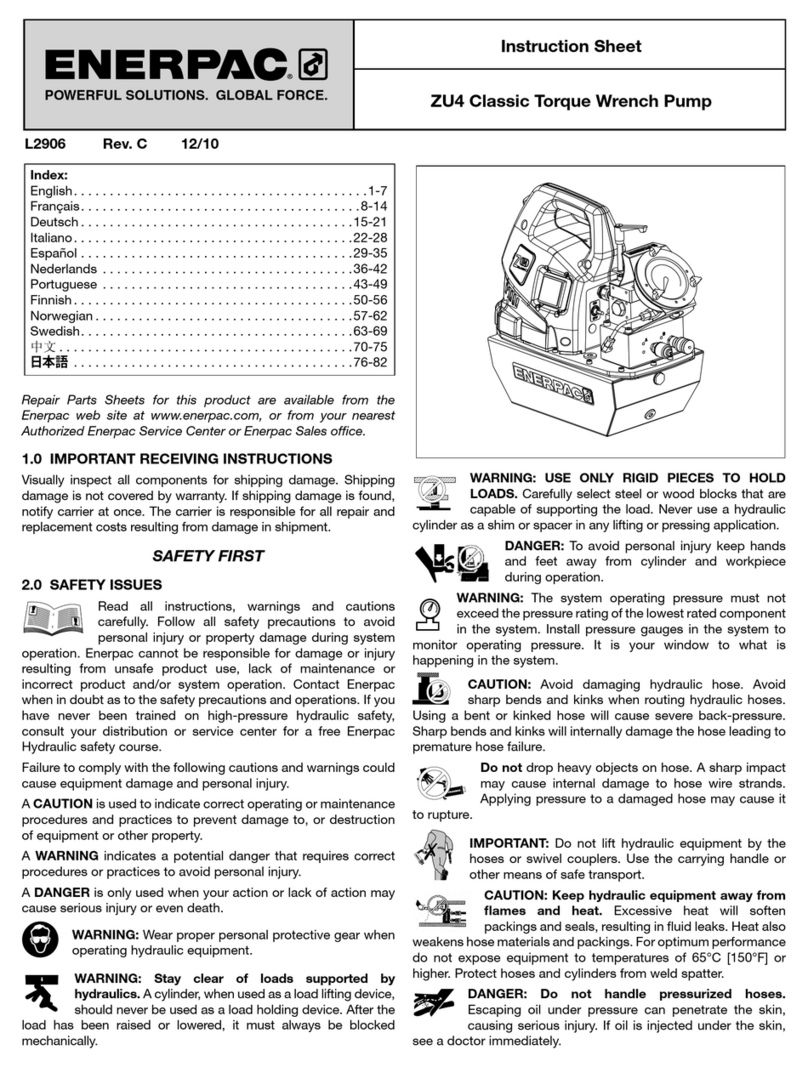
7
SHURflo Operating Instructions, Performance,
Specifications and Parts Manual
Models R30GN, R50GN and R102N
Form L-4095 (12/09)
Check motor.
It may be equipped
with an automatic resetting thermal
protector and may restart unexpectedly
(see specifications chart). Protector tripping
is an indication of motor overloading as a
result of operating the pump at too high a
pressure (over 25 PSI or 60 feet of head), too
high of viscosity, too high of specific gravity,
excessively high or low voltage, inadequate
wiring, incorrect motor connections, too
small a motor (sized incorrectly, not enough
HP), or a defective motor or pump.
Do not handle pump with wet hands or
when standing in water. Failure to follow the
General Safety Information and all warnings
could result in fatal electrical shock!
Installation
IMPORTANT: In any installations where
property damage and/or personal
injury can occur when the pump is
not operating due to power outages,
discharge line freezing, or any other
reason, a back-up system(s) and/or
warning system(s) should be used.
In order to safely use this product,
familiarize yourself with this pump and
also with the liquid (chemical, etc.)
that is going to be pumped through
the unit. This pump is not suitable for
many liquids.
1. Locate the pump as close to the
liquid source as possible, making
the suction line as short and direct
as possible.
PIPING
SUCTION
2.Avoid excessive lengths or number of
fittings and bends in the suction line.
3. Attach suction line to suction inlet
(See Figure 1 for proper rotation).
NOTE: An optional vacuum switch (pump
protector) is recommended to prevent
pump dry run. It should be mounted on
the suction side of the pump. Refer to
installation/operation instructions
provided with vacuum switch.
4. It is recommended that same size
pipe as pump ports be used or, in
cases requiring lengthy piping, the
next larger size pipe be used.
5. If suction level is greater than what
is indicated in the performance
chart, attach a foot valve below
liquid level at end of suction line to
ensure positive priming. Also note:
If fluid specific gravity is greater
than 1.0 or viscosity greater than
500 SSU, a foot valve is also
recommended.
NOTE: If a foot valve (or check valve) is
not used in the suction line, it may be
necessary to refill the pump every time
the unit is stopped and you wish to restart
the pump. This depends on the length of
time between starts and whether or not
the impeller is wet enough to close cavities
to affect a prime.
6. If solid contaminates are suspected
in a liquid, place a filter in the
suction line.
7. Be certain all suction piping connec-
tions are airtight.
NOTE: Assure airtight pipe connections
with the use of a pipe joint sealant.
DISCHARGE
8. Attach discharge piping to the
discharge outlet.
Support pump and
piping during assembly
and after installation. Failure to do so may
cause piping to break, pump to fail, motor
bearing failures, etc., all of which can result in
property damage and/or personal injury.
NOTE: Should the pump need to be
self-draining, the pump head should be
mounted in the vertical position with
the suction port facing down. When
pumping high viscosity fluids, the
vertical position can be used with the
suction port facing up and the pump
mounted under the source. Increasing
the suction pipe size and eliminating
bends and elbows also assists in pump-
ing high viscosity fluids. Max. viscosity is
500 SSU at 1725 RPM.
9. If a shut-off valve or handgun is
required in discharge line, provide
apressure relief valve for pump
protection.
Shutting off
discharge without
providing pressure relief can cause extreme
overpressure which can result in pump
and/or motor failure. Do not exceed 25 PSI
(or 60 feet of head) pump or system pressure.
10. Operation under shut-off discharge
conditions will overheat and
damage pump and impeller.
NOTE: Globe valve or other restrictive
valves should not be used as shut-off
mechanism as they are restrictive in
nature and will seriously affect pump
performance.
11. After all piping and controls (not
supplied with unit) have been
installed, unit is ready for operation.
Operation
Do not run pump
dry, as permanent
damage to the pump impeller, seal, pump
housing and wear plates will result. Suction
pressure should never be greater than the
discharge pressure. Dry running will result in
immediate failure of impeller and cause
extreme pump temperature (do not handle
pump when hot). Impeller damage is not
covered under warranty.
1. All pumps must be primed before
start-up and filled with fluid (See
Figure 3). Never operate a pump
unless it is secured to a solid foun-
dation and all safety shields are
installed.
Upon start-up, maintain a minimum
of 15 PSI (1 BAR) operating pressure
on the pump. This will allow any
remaining air to be driven from the
seal chamber and will ensure liquid
circulation to the seal.
2. Flexible impeller pumps are built
to very close tolerances and this
















